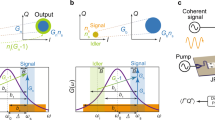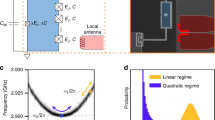Abstract
An ideal amplifier has very low noise, operates over a broad frequency range, and has large dynamic range. Unfortunately, it is difficult to obtain all of these characteristics simultaneously. For example, modern transistor amplifiers offer multi-octave bandwidths and excellent dynamic range, but their noise remains far above the limit set by the uncertainty principle of quantum mechanics. Parametric amplifiers can reach the quantum-mechanical limit, but generally are narrow band and have very limited dynamic range. Here we describe a parametric amplifier that overcomes these limitations through the use of a travelling-wave geometry and the nonlinear kinetic inductance of a superconducting transmission line. We measure gain extending over 2 GHz on either side of an 11.56 GHz pump tone and place an upper limit on the added noise of 3.4 photons at 9.4 GHz. The dynamic range is very large, and the concept can be applied from gigahertz frequencies to ∼ 1 THz.
This is a preview of subscription content, access via your institution
Access options
Subscribe to this journal
Receive 12 print issues and online access
$209.00 per year
only $17.42 per issue
Buy this article
- Purchase on Springer Link
- Instant access to full article PDF
Prices may be subject to local taxes which are calculated during checkout




Similar content being viewed by others
References
Day, P. K., LeDuc, H. G., Mazin, B. A., Vayonakis, A. & Zmuidzinas, J. A broadband superconducting detector suitable for use in large arrays. Nature 425, 817–821 (2003).
Wallraff, A. et al. Strong coupling of a single photon to a superconducting qubit using circuit quantum electrodynamics. Nature 431, 162–167 (2004).
Zmuidzinas, J. Superconducting microresonators: Physics and applications. Annu. Rev. Condens. Matter Phys. 3, 169–214 (2012).
Castellanos-Beltran, M. A., Irwin, K. D., Hilton, G. C., Vale, L. R. & Lehnert, K. W. Amplification and squeezing of quantum noise with a tunable Josephson metamaterial. Nature Phys. 4, 929–931 (2008).
Yamamoto, T. et al. Flux-driven Josephson parametric amplifier. Appl. Phys. Lett. 93, 042510 (2008).
Bergeal, N. et al. Phase-preserving amplification near the quantum limit with a Josephson ring modulator. Nature 465, 64–68 (2010).
Spietz, L., Irwin, K., Lee, M. & Aumentado, J. Noise performance of lumped element direct current superconducting quantum interference device amplifiers in the 4–8 GHz range. Appl. Phys. Lett. 97, 142502 (2010).
Hover, D. et al. Superconducting low-inductance undulatory galvanometer microwave amplifier. Appl. Phys. Lett. 100, 063503 (2012).
Mück, M., Kycia, J. B. & Clarke, J. Superconducting quantum interference device as a near-quantum-limited amplifier at 0.5 GHz. Appl. Phys. Lett. 78, 967–969 (2001).
Zimmer, H. Parametric amplification of microwaves in superconducting Josephson tunnel junctions. Appl. Phys. Lett. 10, 193–195 (1967).
Moshovich, R. et al. Observation of zero-point noise squeezing via a Josephson parametric amplifier. Phys. Rev. Lett. 65, 1419–1422 (1990).
Louisell, W. H., Yariv, A. & Siegman, A. E. Quantum fluctuations and noise in parametric processes. I. Phys. Rev. 124, 1646–1654 (1961).
Caves, C. M. Quantum limits on noise in linear amplifiers. Phys. Rev. D 26, 1817–1839 (1982).
Pospieszalski, M. W. Extremely low-noise amplification with cryogenic FETs and HFETs: 1970–2004. IEEE Microw. Mag. 6, 62–75 (2005).
Vijay, R., Slichter, D. H. & Siddiqi, I. Observation of quantum jumps in a superconducting artificial atom. Phys. Rev. Lett. 106, 110502 (2011).
Clarke, J. & Braginski, A. I. The SQUID Handbook: Fundamentals and Technology of SQUIDs and SQUID Systems 1st edn (Wiley-VCH, 2004).
Irwin, K. D. in AIP Conf. Proc. (eds Young, B., Cabrera, B. & Miller, A.) 229–236 (American Institute of Physics Conference Series, Vol. 1185, 2009).
Cullen, A. L. A travelling-wave parametric amplifier. Nature 181, 332 (1958).
Tien, P. K. Parametric amplification and frequency mixing in propagating circuits. J. Appl. Phys. 29, 1347–1357 (1958).
Hansryd, J., Andrekson, P. A., Westlund, M., Li, J. & Hedekvist, P. O. Fiber-based optical parametric amplifiers and their applications. IEEE J. Sel. Top. Quant. Electron. 8, 506–520 (2002).
Foster, M. A. et al. Broad-band optical parametric gain on a silicon photonic chip. Nature 441, 960–963 (2006).
Tong, Z. et al. Towards ultrasensitive optical links enabled by low-noise phase-sensitive amplifiers. Nature Photon. 5, 430–436 (2011).
Sweeny, M. & Mahler, R. A travelling-wave parametric amplifier utilizing Josephson junctions. IEEE Trans. Magn. 21, 654–655 (1985).
Yurke, B., Roukes, M. L., Movshovich, R. & Pargellis, A. N. A low-noise series-array Josephson junction parametric amplifier. Appl. Phys. Lett. 69, 3078–3080 (1996).
Parmenter, R. H. Nonlinear electrodynamics of superconductors with a very small coherence distance. RCA Rev. 23, 323–352 (1962).
Anthore, A., Pothier, H. & Esteve, D. Density of states in a superconductor carrying a supercurrent. Phys. Rev. Lett. 90, 127001 (2003).
Landauer, R. W. Superconductive parametric amplifier. US Patent 3,111,628 (1963).
Tholen, E. A. et al. Nonlinearities and parametric amplification in superconducting coplanar waveguide resonators. Appl. Phys. Lett. 90, 253509 (2007).
Leduc, H. G. et al. Titanium nitride films for ultrasensitive microresonator detectors. Appl. Phys. Lett. 97, 102509 (2010).
Mattis, D. C. & Bardeen, J. Theory of the anomalous skin effect in normal and superconducting metals. Phys. Rev. 111, 412–417 (1958).
Pearl, J. Current distribution in superconducting films carrying quantized fluxoids. Appl. Phys. Lett. 5, 65–66 (1964).
Anlage, S. M., Snortland, H. J. & Beasley, M. R. A current controlled variable delay superconducting transmission-line. IEEE Trans. Magn. 25, 1388–1391 (1989).
Stolen, R. & Bjorkholm, J. Parametric amplification and frequency conversion in optical fibers. IEEE J. Quant. Electron. 18, 1062–1072 (1982).
Landauer, R. Shock waves in nonlinear transmission lines and their effect on parametric amplification. IBM J. Res. Dev. 4, 391–401 (1960).
Su, H. T., Wang, Y., Huang, F. & Lancaster, M. J. Superconducting delay lines. J. Supercond. 21, 7–16 (2005).
Acknowledgements
The research was carried out at the Jet Propulsion Laboratory (JPL), California Institute of Technology, under a contract with the National Aeronautics and Space Administration and has been supported in part by NASA (Science Mission directorate), the Keck Institute for Space Studies, the Gordon and Betty Moore Foundation and the JPL Research and Technology Development program.
Author information
Authors and Affiliations
Contributions
B.H.E. carried out the measurements and analysed the data. P.K.D. contributed to the device concept, designed the devices, planned the measurements, analysed the data and wrote the paper. H.G.L. developed the fabrication methods and made the devices. J.Z. contributed to the device concept and the writing of the paper.
Corresponding author
Ethics declarations
Competing interests
The authors declare no competing financial interests.
Supplementary information
Supplementary Information
Supplementary Information (PDF 755 kb)
Rights and permissions
About this article
Cite this article
Ho Eom, B., Day, P., LeDuc, H. et al. A wideband, low-noise superconducting amplifier with high dynamic range. Nature Phys 8, 623–627 (2012). https://doi.org/10.1038/nphys2356
Received:
Accepted:
Published:
Issue Date:
DOI: https://doi.org/10.1038/nphys2356
This article is cited by
-
Study of Coupling in Superconducting Transmission Lines
Journal of Superconductivity and Novel Magnetism (2024)
-
A Review of Developments in Superconducting Quantum Processors
Journal of the Indian Institute of Science (2023)
-
Kerr reversal in Josephson meta-material and traveling wave parametric amplification
Nature Communications (2022)
-
Quantum-noise-limited microwave amplification using a graphene Josephson junction
Nature Nanotechnology (2022)
-
The Simulation and Design of an On-Chip Superconducting Millimetre Filter-Bank Spectrometer
Journal of Low Temperature Physics (2022)



